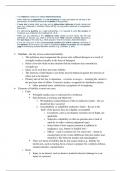Samenvatting
Tort Law - A Summary of the New Textbook for Global Law (2024)
These notes are a summary of the new textbook for the Global Law course by Professor Tjong Tjin Tai. They include summaries of the main concepts, processes and laws from all chapters (excluding Chapter 16 - Tort law around the world - which you will likely not need for the exam). The notes are ...
[Meer zien]




